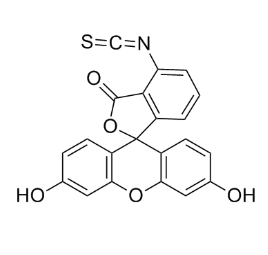文献:Plugging the leak of nanoparticles by interfacial polymer adsorption enables an efficient protein and peptide encapsulation
文献链接:https://onlinelibrary.wiley.com/doi/abs/10.1002/adfm.202310146
作者:Qingqing Huo, Yue Gao, Wenbo Wu, Shuai Hu, Enpeng Dong, Yiyang Zhang, Yuling Tian, Yang Huang, Peng Quan, Dongfei Liu
相关产品:FITC(异硫氰酸荧光素)
原文摘要:
Encapsulation is a promising technology to enhance the pharmacokinetic properties of proteins and peptides, particularly addressing their short half-life. Despite its potential, this method has limitations, such as low encapsulation efficiency, a minimal mass fraction of therapeutic agents, and the potential loss of biological activity. In this study, the pivotal role of amphiphilic polymers in achieving efficient protein and peptide encapsulation is delved into. It is found that these polymers not only improve the solvation of cargo nanoparticles but also form a robust 3D polymer layer at the oil/water interface. This interfacial polymer barrier effectively minimizes the escape of proteins and peptides during the encapsulation process, achieving an impressive encapsulation efficiency of up to 99.8% for agents. Remarkably, the mass fraction of these therapeutic agents in the resultant microparticles exceed 59.9 wt.%. The microparticles prolonged payload release for 30 days both in vitro and in vivo, leading to heightened therapeutic efficacy in type 2 diabetic rats. Furthermore, the required amount of polymer for administration is reduced by a factor of 47.5, substantially mitigating inflammatory response at the injection site. In conclusion, the findings highlight the transformative potential of using interfacial polymer accumulation to encapsulate proteins and peptides.
FITC:FITC 是异硫氰酸荧光素(Fluorescein Isothiocyanate)的英文缩写。FITC 的分子式为C21N11NO5S,它是一种有机荧光染料。其分子结构中含有异硫氰酸酯基团(-N = C = S),这个基团能够与生物分子中的氨基(-NH₂)等活泼基团发生化学反应,从而实现对生物分子的标记。它在常温下一般为黄色粉末状物质,在溶解状态下具有很强的荧光特性。FITC 在 490 - 495nm 波长的光激发下,会在 520 - 530nm 波长处发射出明亮的黄绿色荧光,这使得它在荧光检测技术中非常容易被识别。基于FITC 相关性能,介绍如下:

图:FITC结构式
标记过程:
若两亲性聚合物溶解性不佳,可先加入适量的有机溶剂,在磁力搅拌器上进行搅拌,使其充分溶解形成均匀的溶液。然后再缓慢加入配制好的缓冲溶液,边加边搅拌,逐步将体系转变为以缓冲溶液为主的环境,同时要注意观察聚合物溶液的状态,确保其一直处于溶解良好、均匀分散的状态。若聚合物本身易溶于缓冲溶液,则可直接将其加入到适量的缓冲溶液中,利用磁力搅拌器搅拌至完全溶解,形成澄清透明的聚合物溶液。
在搅拌状态下,将称取好的 FITC 粉末缓慢加入到已溶解好的两亲性聚合物溶液中。由于 FITC 对光和湿度较为敏感,操作过程要尽量迅速,并且要避免其接触过多的水分。调节磁力搅拌器的搅拌速度,使反应体系能够充分混匀,一般选择适中的搅拌速度,避免搅拌过快产生过多气泡或者导致溶液溅出等情况。然后将反应容器置于合适的温度环境下进行反应,通常可以选择室温或者根据聚合物及 FITC 的化学特性选择特定的温度,反应时间依据具体的聚合物和 FITC 浓度、反应活性等因素确定。在反应过程中,可以通过荧光光谱仪等仪器对反应体系进行适时监测,观察荧光强度等相关指标的变化情况,以此来初步判断 FITC 与两亲性聚合物的结合情况以及反应进行的程度。
结论:
该文献成功制备出一种两亲性聚合物,此聚合物能够实现高效蛋白质和肽封装,用FITC标记以供后续实验。FITC 标记的两亲性聚合物可用于细胞成像。两亲性聚合物能够与细胞膜相互作用。亲水部分可与细胞外的水环境相互作用,而疏水部分与细胞膜的脂质双分子层相互作用,方便实验观察。这些聚合物不仅改善了货物纳米粒子的溶剂化,而且还在油/水界面形成了坚固的 3D 聚合物层。

 2025-08-06 作者:ws 来源:
2025-08-06 作者:ws 来源:

